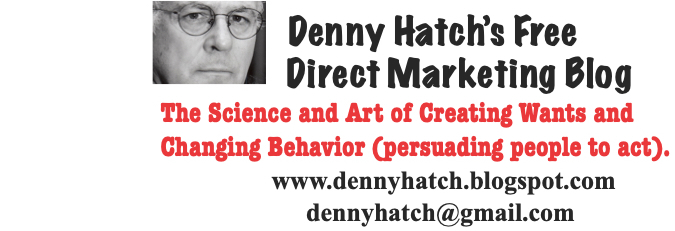ISSUE
#25 –Wednesday, September 26, 2018
Posted
by Denny Hatch
Dealing
with Customer Misery
Turn Customer Panic into Comfort—Automatically
We’ve
all been there—a flight delay caused a missed connection.
Suddenly
you’re in a long line of fretting, scared travelers waiting for a glum, harassed
clerk to bombard you with various options, connections and decisions.
One night in April we left Philadelphia on a KLM/Delta flight to Amsterdam’s Schiphol Airport with a four-hour layover for our
connection to Basel, Switzerland.
Three hours into the flight over Newfoundland the pilot came on the horn to
announce the plane had lost a generator. The Boeing 767-300 has two engines and
three generators. Two were working. But we were not allowed to fly
across the ocean without a working spare third generator, so we were returning to
Philadelphia.
On the way back to Philly, an announcement
from the cockpit assured passengers with connections that we would be rebooked.
Back at the Philly airport we were told not to try to rebook flights. We were assured all the information would be awaiting us at Schiphol.
Philadelphia had no spare 767-300 generator in inventory, so one had to be located and flown to Philly. Further delay.
Back at the Philly airport we were told not to try to rebook flights. We were assured all the information would be awaiting us at Schiphol.
Philadelphia had no spare 767-300 generator in inventory, so one had to be located and flown to Philly. Further delay.
Seven hours later we took off for an uneventful
flight to Amsterdam.
At Schiphol, a KLM gate attendant told us we
could pick up all the information—including new boarding passes—at a
Self-Service Transfer kiosk.
We would see it at the end of the hallway to our right after passport control.
We would see it at the end of the hallway to our right after passport control.
Look for the yellow sign.
Dutch Wizardry
At each kiosk, scanning instructions were absolutely
clear.
I pressed the old Amsterdam-Basel boarding pass against
the glass for scanning, whereupon this marvelous machine started spitting out
myriad personalized forms.
Not shown here: the revised itinerary and 10-Euro food voucher for use
anywhere in the airport
More than 100 such kiosks at Schiphol are loaded with
these blank forms that can be printed out personalized for myriad uses.
Let’s say 280 of our fellow passengers missed
connections. Problem automatically solved as promised.
No one needed to go through the stomach-churning
experience of standing in long lines and dealing with an equally harried human being.
True the delay was a bit of downer. But KLM’s
technology is dazzling.
This was Customer Relationship Magic at its
best—efficient, and best of all automated.
It was quick and seamless for us.
Cheap and easy for KLM.
It was quick and seamless for us.
Cheap and easy for KLM.
We felt loved.
Takeaways to Consider
• A seamless automated system does not get tired, cranky
and desperate for a smoke or bathroom break while interacting with a stressed-out, confused customer.
• An automated system that handles routine customer
problems eliminates personnel and saves big money.
• CRM—Can you turn Customer Relationship Misery
into Customer Relationship Magic using an automated system?
• "Times of adversity and customer screw-ups may be the only times when you can really show your customers how much you love them."
—Malcolm Decker, Freelancer, entrepreneur
• "Times of adversity and customer screw-ups may be the only times when you can really show your customers how much you love them."
—Malcolm Decker, Freelancer, entrepreneur
• When traveling with myriad connections for an important meeting, speech or cruise, consider leaving a day early. If the flight is delayed, you're covered. If you arrived a day early, you can relax, maybe do a bit of sightseeing and hey! you're on your way to getting over jet lag!
###
Word count: 526










